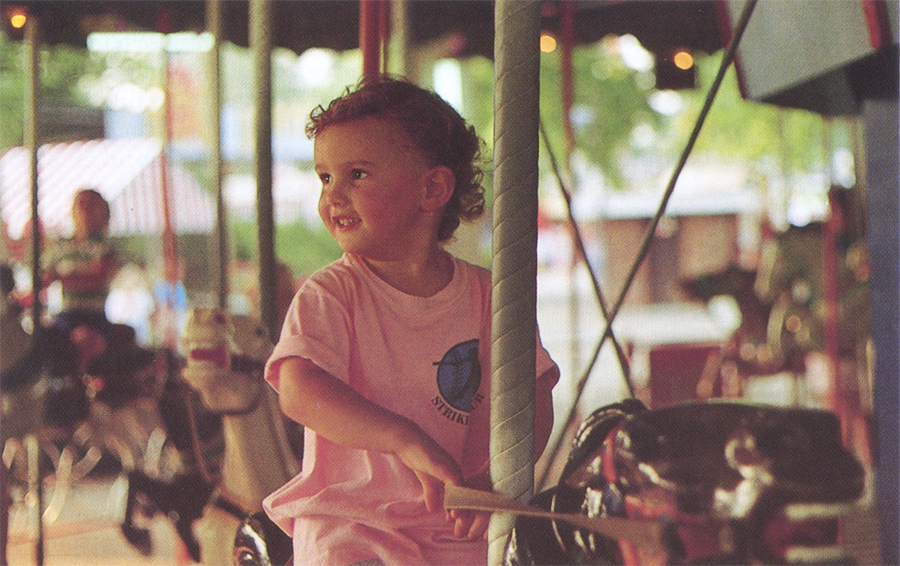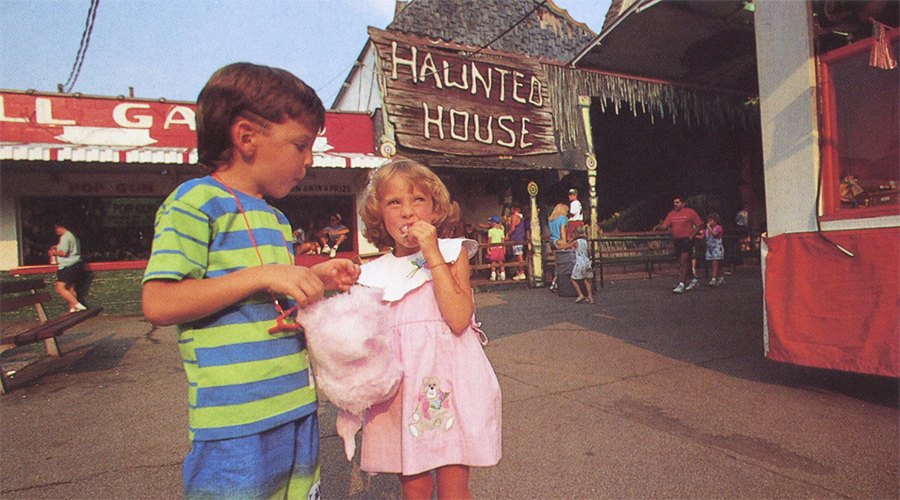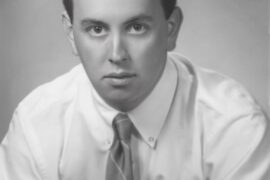By Joseph Platania
HQ 4 | SUMMER 1990
Calliope music and the rumble and clickety-clack of the roller coaster mingle with shrieks and peals of laughter from children driving miniature cars on a Iittle track. The spicy aroma of pizza and the sweet smell of cotton candy penetrate the crowds milling along the shaded midway of Camden Park.
That’s quite different from the days when a Sunday afternoon meant dapper Huntington gentlemen escorting their sweethearts aboard the streetcar to Camden for a picnic.
Camden Park began as a picnic grove established by the Camden Interstate Railway to boost weekend and holiday traffic. Unlike most streetcar parks, Camden has survived as West Virginia’s only amusement park and one of the state’s oldest commercial ventures.
When Camden Park opened, Teddy Roosevelt was president and the ragtime of Scott Joplin and marching music of John Philip Sousa emanated from local bandstands. Later, the park would be the setting for the first local baseball games, thousands of picnics, fairs, marathon dancing, roller derbies, flagpole sitting, a swimming pool, a zoo and scores of rides.
Camden Park is on property originally owned by Samuel Sperry Vinson who owned 10,000 acres near the Ohio and Big Sandy rivers. His oldest son, Zachary Taylor Vinson, took a great interest in local railroading, especially in street railways. In 1899 he began gathering rail lines that were combined as the Camden Interstate Railway in 1903. The company was named for its principal owner, Senator Johnson Newlon Camden of Parkersburg.
Although electric streetcars were rolling on Huntington’s streets in December 1888, they made little progess until Z.T. Vinson persuaded investors of the need for interurban service. He interested Sen. Camden, a railroad builder and a big-league capitalist, in the idea. It was on Camden’s behalf that Vinson in 1899 acquired the streetcar companies and subsidiary operations serving Catlettsburg and Ashland, Ky., and Ironton, Ohio. By the end of the year Vinson had incorporated the Ohio Valley Electric Co. and arranged to buy Huntington’s electric railway company. A connecting line and bridge were built across the Big Sandy River and service between Huntington and Ashland was begun in July 1903.
The Camden Interstate line’s exchange point between Huntington and Ashland fell near the confluence of Twelvepole Creek and the Ohio River just west of Huntington. A 27-acre tract of level farmland, part of old Sam Vinson’s holdings, lay nearby. A natural, tree-shaded site for picnicking, it was clubbed Camden Park and opened to the public. Doris Miller states in her
Centennial History of Huntington, 1871-1971, that with power drawn from the streetcar cable, Camden Park was one of the first places in that part of Wayne County to have electric lights.
In 1903 a pavilion was built for picnics, square dancing and family reunions. Some rides, including the merry-goround used today, were installed in 1907. Around 1910 Camden Park, with seven rides and a swimming pool, hired Colonel E.G. Via as manager. According to one account, Via had been in the restaurant business in Virginia. In 1916, he bought Camden Park from the streetcar company.

Camden bustled during the three decades of Via ownership. The local musicians’ union sponsored concerts by the Huntington Citizen’s Band, which also played for summer dances at the park. There was a large pool with a diving board and slide, one of the first open to the public. “The park had its own well and pump and the water in the pool was generally ice cold,” local historian Byron Morris remembers of the 1920s.
Morris recalled prizefights at the park grounds. West Virginian Bob Martin, the heavyweight champion of the World War I American Expeditionary Force, fought there.
The Depression made Camden Park “a real white elephant,” according to Morris. “Someone then could have bought the park for a song,” he figured. A faltering economy was just one change affecting the park. The streetcar gave way to new streets and eventually to a modern concrete highway – U.S. 60. The 1937 Ohio River flood, which covered the park, and then World War II caused major setbacks. By 1946, patronage had reached a low. That year Colonel Via’s heirs sold Camden to James P. Boylin, a Huntington furniture dealer.
Boylin, with Harry Nudd of Chicago and HJ. Malloy, formed a corporation to run the park. Several years later Malloy was replaced with R.M. “Bob” Burley.
The new partners found Camden Park dirty and damaged by the 1937 flood. Nudd and his crew went to work cleaning, repairing and rebuilding. “Back then it was just cinders and sawdust, outdoor toilets and a few wooden shacks,” Nudd remembers. “Believe me, it took a lot of hard work. We also had to put back most of the profits to make the place what it is today.
“Beer was a major source of income when I came here,” he continued. “The restaurant used to be a beer garden. But when you have beer you’re asking for trouble. So we did away with it back in ’51.”
Nudd recalled that the first ride bought under the new management was called the “Caterpillar.” It came from the old Coney Island amusement park in Cincinnati and has long since been replaced, as has the original Ferris wheel. Camden Park developed a good relationship with Coney Island, according to Nudd. “Coney Island kept rides three or four years before selling them and I had the first choice on their rides and other amusement park equipment,” he said.
The old roller coaster came down in 1957 to make way for the current Big Dipper. “I was afraid of that old roller coaster, which had the old-fashioned wooden tracks and single cars,” Nudd said. “So I finally tore it down at the end of the season and built a new one with a set of plans I got for $3,500 from a Dayton, Ohio, amusement company.”
Nudd built the Big Dipper in seven weeks. He bought cars and trains readymade and purchased lumber from a Huntington lumberyard. The 45-foothigh coaster opened in 1958. The Big Dipper provides the sights and sounds that purists love. The immense crisscross wooden superstructure ensures the squeaks as well as the ear-pounding roar and rough-and-tumble feel that are lost in low-riding, silent steel coasters now popular in large theme parks. Nunn said Camden’s coaster gives a smoother ride.
Until 1971, Camden Park had the only permanent zoo within 150 miles. During its heyday the zoo had a menagerie consisting of an elephant, deer, llamas, a variety of monkeys, lions, prairie dogs, bears and fowl. George the sea lion gained national attention when he escaped into the Ohio River and swam more than 200 miles downstream before being captured and returned.
Office manager Erma Lowe has been with the park since 1963, but her memories go back much farther. The roller coaster has remained the most popular ride through the years, and the dodge ’em cars second, she said. Park managers used to weigh tickets collected for individual rides and could judge popularity that way. With a single admission now good for all rides all day, it is more difficult to gauge a ride’ s success, she noted.
The park has added a new ride every four or five years and tries to have a new attraction every other year, according to Lowe. The newest rides are the stomach-churning Tip Top and the Thunderbolt Express, an upside-down looping roller coaster that runs forward and backward. This new coaster is a “major ride that parks our size just don’t have,” said park manager Gary Frye.
Lowe said that the Ferris wheel has been gone for more than 12 years. “We couldn’t find a qualified operator for the ride, one who knew how to balance the cars on the wheel.” A flying scooter ride took its place, she said, and the Haunted House took the place of a midway attraction called “Laff in the Dark.”
A roller rink has been a Camden fixture for more than 50 years.

In 1978, the sternwheeler Camden Queen was added to the park’s attractions. It gives a 45-minute ride on the Ohio River, leaving from the park’s landing on Twelvepole Creek. The Queen is a reproduction of an 1886 packet boat that traveled the Ohio. The boat is the property of Captain Gene Lister, a river man since he was 16.
The late Bob Burley, Nudd’s assistant manager, had just graduated from then Marshall College when he went to work at Camden Park. “During the park’s season, Burley and I would be at the park every day, seven days a week,” Nudd said.
Each year during the 1980s about 500,000 visitors, most of them from Kentucky, Ohio, and West Virginia, passed through Camden Park’s turnstiles. The park hosts 15,000 or more visitors each Independence Day holiday when star entertainers and fireworks are offered. About 160 people are employed full-time at the height of the season. Only 15 are employed yearround.
Nudd knows why Camden has survived competition from the larger theme parks in neighboring states. “For one thing, it is the only amusement park in this part of the country,” he explained. ‘Then, too, it has been well maintained. It is a real safe place. Parents can drop their kids off here and go shopping, knowing the kids will be OK.”
After Nudd’s retirement in 1980, Camden Park was sold to investors from Virginia. B.R. Roberts, one of the owners, is now general manager of the park.
Surviving both the time and competition, the 27-acre fun park has served more than three generations of TriState residents. Whether it’s the cozy size or venerable tradition, 87-year-old Camden Park remains young at heart and keeps visitors coming back to the sign of the happy clown.




